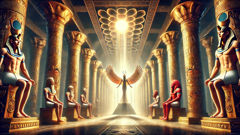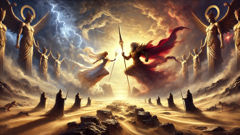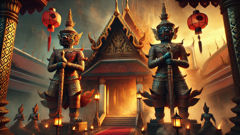Introduction
In the shadow of the pyramids, where the Nile’s emerald ribbons cut through gold and ochre sands, the destiny of Egypt hung not on the whims of mortals but on the struggles of gods. Before pharaohs wore crowns and scribes etched their names into eternity, the gods themselves vied for mastery. Among them, none captured the imagination more than the rivalry between Horus—the falcon-headed guardian of kingship, born of tragedy and prophecy—and his uncle Set, the tempestuous lord of chaos, deserts, and storms. Their story is woven through the very heart of Egyptian mythology, echoing in temple walls and painted on tomb ceilings. It’s a tale alive with cunning, courage, betrayal, and endurance—a struggle not just for the throne, but for the soul of a civilization.
The tale begins in a time when gods walked among men, their forms both awe-inspiring and terrifying, their disputes as thunderous as the annual flooding of the Nile. Osiris, the wise and beloved king, had brought prosperity to Egypt, teaching the people justice, agriculture, and reverence for Ma’at—the divine order that kept chaos at bay. But Osiris’s jealous brother, Set, coveted power and would stop at nothing to seize the throne. Driven by envy and wrath, Set murdered Osiris, casting his body into the Nile, scattering him across the land. Isis, Osiris’s loyal queen, gathered the pieces of her husband’s body, using her magic and devotion to restore him. From their love, Horus was conceived—a child born in secrecy, hidden from Set’s watchful eye, destined to avenge his father and claim his rightful place.
As Horus grew, so too did the tension between order and chaos. Guided by Isis’s wisdom and the silent counsel of Osiris’s spirit, Horus learned the arts of war, justice, and kingship. Set, meanwhile, ruled from his barren deserts, his power unchecked save for the promise of Horus’s challenge. The gods themselves grew divided—some siding with the youthful Horus, others with the seasoned, unpredictable Set. And so began the Contendings, a series of trials, battles, and debates before the divine tribunal of the Ennead, where every victory and setback would shape not only the fate of gods, but the destiny of Egypt itself.
Set’s Betrayal and Horus’s Hidden Childhood
The palace at Abydos was once filled with laughter, light, and abundance. Osiris, the green-skinned king, presided with kindness and wisdom, his queen Isis ever at his side. The gods of Egypt—Thoth, wise scribe; Hathor, radiant with joy; Bastet, fierce and nurturing—gathered often in celebration. But beneath the surface, disquiet simmered. Set, Osiris’s brother, watched from afar, his heart churning with resentment. He envied Osiris’s gifts—the adoration of mortals, the lush lands under his sway, the love of Isis. Set’s own domain was the desert, where only storms obeyed him, and no crops grew.

With cunning born of desperation, Set hatched a scheme that would forever change the fate of Egypt. On the eve of a great festival, he invited Osiris to a feast. Amidst music and wine, Set presented a splendid chest inlaid with cedar and gold, claiming it was a gift for whomever could fit inside. Each guest tried and failed until Osiris, encouraged by laughter, entered the chest. Before Osiris could rise, Set slammed the lid shut and sealed it with molten lead. The laughter died. With the help of conspirators, Set carried the chest to the Nile and cast it into the river’s heart.
Isis’s grief was as vast as the floodwaters that carried Osiris away. Disguised and tireless, she searched the length of Egypt, accompanied by her sister Nephthys and the loyal Anubis. She found Osiris’s body entangled among papyrus reeds in the marshes of Byblos. Yet Set was relentless—even in death, he feared Osiris’s return. He found the body and tore it into fourteen pieces, scattering them across Egypt. Isis, with patience and magic, reclaimed each piece, weaving them together with spells and tears. Her devotion stirred the gods, and even Ra, the sun god, wept for Osiris.
In secret, Isis revived Osiris just long enough for them to conceive a child—Horus, the falcon. But Set’s spies roamed everywhere. To protect her son, Isis hid with him in the marshes of Khemmis, veiling herself in reeds and calling on scorpions for guardianship. Life in hiding was perilous: Set’s storms lashed the marshes, crocodiles prowled, and famine threatened. Yet Isis nurtured Horus with milk and stories of his noble father, instilling in him a burning sense of justice.
As Horus grew, he displayed the gifts of both parents—his father’s resolve, his mother’s cunning. Isis taught him spells to heal and to strike, to transform his appearance, to summon wind or water. Thoth visited, imparting wisdom and secrets of the gods. In dreams, Osiris’s spirit guided Horus, urging him to reclaim the throne and restore Ma’at to Egypt. But Set’s shadow lengthened: rumors spread of his cruelty, of temples defiled, of priests banished from their sanctuaries. The land grew restless, its people whispering prayers for a savior.
When Horus reached manhood, he rose from the marshes like a falcon from its nest, his eyes alight with purpose. Isis fashioned him armor from silver and gold, a crown shaped like the double plumes of Upper and Lower Egypt. The gods watched as Horus emerged from hiding—no longer a hunted child, but a challenger ready to confront the usurper. Across Egypt, statues of Horus were adorned with fresh flowers, incense filled the air, and the hope of a just ruler returned to every heart. But Set would not relinquish his stolen throne without a struggle, and so began the legendary Contendings that would decide Egypt’s fate.
The Divine Tribunal and the Epic Trials
When Horus presented himself to the gods at Heliopolis, demanding justice for his father’s murder and his own right to rule, the Ennead gathered. Nine great gods—Ra, Shu, Tefnut, Geb, Nut, Isis, Nephthys, Thoth, and Hathor—took their places on golden thrones beneath towering lotus columns. Set strode in with the confidence of a storm, his red skin gleaming, his eyes daring any to challenge him. Horus entered in regal silence, the air alive with anticipation.

Ra, the sun god, presided. Though old and wise, Ra hesitated: Set had served as the sun’s defender against the serpent Apophis, and was strong in battle. Horus was young but carried the blood of Osiris. The gods deliberated, their debates lasting days, then weeks. They demanded proofs—of strength, of wisdom, of virtue. Thus began a series of trials, each designed to test the very soul of the contenders.
The first was a contest of transformation. Set proposed they both turn themselves into hippopotamuses and submerge in the Nile. Whoever remained underwater longest would be deemed worthy. As they dove, the river boiled with their struggles. Isis, desperate for her son’s safety, cast a harpoon at Set, but when he pleaded for mercy in Osiris’s name, she relented. Set took advantage, surfacing triumphantly. Horus, angered by his mother’s compassion, left the water in frustration.
The second trial was a race across the desert on stone boats. Set crafted his from heavy limestone, confident in his strength; Horus, clever, built his from wood covered in plaster. As the gods watched, Set’s boat sank immediately while Horus’s glided smoothly over the sand. Set raged, accusing Horus of trickery. The gods argued, their voices echoing like thunder across the dunes.
As the trials wore on, Set tried every form of trickery and violence. In one infamous episode, Set gouged out Horus’s left eye during a nocturnal ambush. The moon itself waned in sympathy. Isis wept, and Thoth intervened, using his magic to heal Horus and restore the Eye—an act that would forever link the Eye of Horus with healing and protection. In another test, Set seduced Horus in an attempt to humiliate him. Horus, ever cunning, turned Set’s scheme back on him, exposing Set’s duplicity before the gods.
Throughout the trials, Isis’s wit proved as vital as Horus’s valor. In one episode, she transformed herself into an old woman and tricked Set into condemning himself before the council. But Set was relentless, threatening to plunge Egypt into eternal chaos if denied the throne. The gods hesitated—each was torn between the old order and the promise of renewal. As seasons passed and crops withered, mortals prayed for resolution. The Ennead debated endlessly, but Ra refused to act decisively.
It was Hathor, goddess of joy, who finally broke the stalemate. Approaching Ra with laughter and song, she soothed his heart, urging him to choose justice over fear. Moved by her words, Ra summoned Osiris from the underworld to offer his wisdom. Osiris spoke with the authority of one who had known both life and death: Egypt would never prosper under chaos. Only a ruler who respected Ma’at could restore balance. The gods nodded in agreement, but Set would not yield. In a final contest—one last battle—the fate of Egypt would be sealed.
The Final Battle and the Restoration of Ma’at
The last trial was not decided by cleverness or debate but by force of arms. The gods gathered atop a sacred plateau at dawn, as the desert wind howled like a thousand jackals. Horus and Set met on the field, flanked by their loyal followers—gods, spirits, and creatures both wondrous and dreadful. The armies of order and chaos assembled in grim anticipation.

Set surged forward first, wielding a bronze-tipped spear crackling with storm energy. His roars shook the stones, sand spiraling around him. Horus met him with shield and sword, feathers of his crown gleaming in the morning light. The clash was thunderous: spear struck shield, sword met claw, and the very earth trembled. Lightning forked above as Set called upon the wild winds; Horus countered with sunlight, drawing power from Ra’s blessing. Their followers joined in, the battlefield echoing with the clamor of battle—gods transformed into animals, serpents uncoiling, lions leaping.
Again and again, Set tried to overwhelm his nephew. He became a monstrous black boar, tusks gleaming. Horus transformed into a golden falcon, diving from the sky to slash at Set’s back. The gods watched in awe as the two changed shapes—a crocodile grappling with a hawk, a serpent writhing against a lion. The duel lasted for days, neither yielding. Set fought with the desperation of one who fears oblivion; Horus with the righteous fury of justice long denied.
In the final hours, Set summoned a sandstorm so dense it blotted out the sun. The world shrank to darkness, chaos reigning. Horus, battered and nearly blind, called upon the memory of his father and the faith of his people. Drawing on Isis’s spells and Thoth’s wisdom, he invoked Ma’at itself—the principle of cosmic order. Light pierced the storm as Horus hurled his spear, striking Set in the heart. Set fell, defeated but not destroyed, his power broken.
The gods descended onto the battlefield. Ra proclaimed Horus the rightful ruler, placing upon his brow the double crown of Upper and Lower Egypt. Isis embraced her son, tears sparkling like morning dew. The people rejoiced: order was restored, crops flourished anew, and the temples rang with hymns to Horus. Set was not destroyed—chaos could never be fully banished—but he was exiled to the deserts beyond civilization, condemned to dwell on Egypt’s edge forever.
Horus ascended the throne, ruling with justice and mercy. The Eye of Horus became a symbol of protection and healing; his story a lesson in perseverance and the ultimate triumph of order over chaos. Egypt’s rivers ran full, her fields grew green again, and Ma’at was restored. The tale of Horus and Set endured in every story, every monument, every prayer—a reminder that even when darkness gathers, hope and justice can prevail.
Conclusion
The legend of Horus and Set is more than a myth—it’s the heartbeat of ancient Egypt’s view of the cosmos. In their epic struggle lies a powerful message: that chaos and order are locked in eternal contest, but balance can be restored through courage, wisdom, and perseverance. For generations, Egyptians saw themselves in this story—the hope that justice would triumph over cruelty, that righteous rulers would overcome the forces of discord. The Eye of Horus adorned amulets and tombs; tales of Isis’s devotion and Horus’s valor guided pharaohs and commoners alike. Even Set’s exile served as a warning that chaos must be respected but never allowed to rule unchecked. In the end, the myth endures because it is not just about gods but about all people who face trials and betrayals, who endure hardship and loss, and who strive for justice in a world forever shifting between shadow and light.












